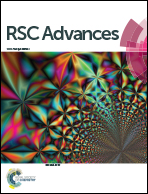Crystal growth control of rod-shaped ε-Fe2O3 nanocrystals†
Abstract
Herein we report crystal growth control of rod-shaped ε-Fe2O3 nanocrystals by developing a synthesis based on the sol–gel technique using β-FeO(OH) as a seed in the presence of a barium cation. ε-Fe2O3 nanocrystals are obtained over a wide calcination temperature range between 800 °C and 1000 °C. A low calcination temperature (800 °C) provides an almost cubic rectangular-shaped ε-Fe2O3 nanocrystal with an aspect ratio of 1.4, whereas a high calcination temperature (1000 °C) provides an elongated rod-shaped ε-Fe2O3 nanocrystal with an aspect ratio of 3.3. Such systematic anisotropic growth of ε-Fe2O3 is achieved due to the wide calcination temperature in the presence of barium cations. The surface energy and the anisotropic adsorption of barium on the surface of ε-Fe2O3 can explain the anisotropic crystal growth of rod-shaped ε-Fe2O3 along the crystallographic a-axis. The present work may provide important knowledge about how to control the anisotropic crystal shape of nanomaterials.



 Please wait while we load your content...
Please wait while we load your content...